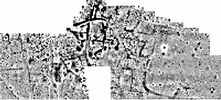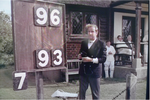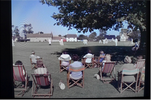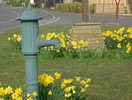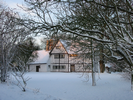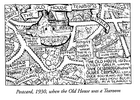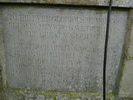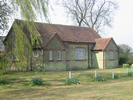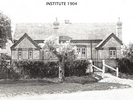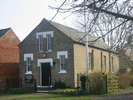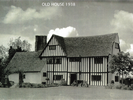A Brief History |
|||
 |
 |
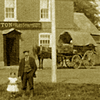 |
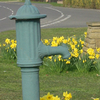 |
 |
 |
 |
 |
Mediaeval Eltisley |
Tudor England |
Victorian Times |
The 20th Century |
The 20th Century |
| [click on images to enlarge] |
| 2015 |
‘Remembering Eltisley’s Fallen 1914 – 1918’ wins an award!In September 2015 we were presented with an award by the Cambridgeshire Association for Local History for publishing one of 2014’s best books on the local history of Cambridgeshire. |
|
| 2014 |
|
|
| 2004 |
John Gater (of Time Team fame) came to do a Geophysical Survey in fields around the village. |
|
| 1973 |
Chapel DemolitionThe Wesleyan Methodist Chapel in Caxton End was demolished in January. |
|
| 1967 |
Filming took place on the village Green for an episode of the cult TV series The Prisoner directed by David Tomblin and staring Patrick McGoohan. The episode was “The Girl Who Was Death” and many residents were extras, either as cricketers or in the crowd scenes. |
|
| 1959 |
New Church OrganA new church organ was dedicated on 24th July. |
|
| 1950 |
Mains water arrives in Eltisley and the district council announced they would no longer maintain the 3 village pumps. |
|
| 1948 |
The Thanksgiving Organ is dedicatedOn June 6th the Thanksgiving Organ was dedicated and a memorial plaque to fallen heroes Private John Hall and leading Seaman Ronald Mitchell was unveiled. The Bishop of Ely officiated and the service was followed by a recital on the new organ. The St Neots Advertiser reported that the church ‘was filled, perhaps as never before in its long history’. |
|
| 1930 |
The Old House Tea Room |
|
| 1920 |
The Lychgate at the entrance to the churchyard is erected in memory of the men of the parish who fell in the First World War. It cost just over £100 and the money was raised by subscription, orgainsed by the Womens Institute. The Lychgate was designed by Architect Mr G M Oldrid Scott, Deans Yard, Westminster and built by Mr C G Evans of St Neots. There is an inscription in Lombardic capitals “Death is swallowed up in Victory”. Under cover are two panels bearing the inscription “To the ever glorious memory of Eltisley men who gave their lives in the in the Great War 1914-1918. Faithful Unto Death” and the names of the 14 men who died. |
|
| 1903 |
The Eltisley & Croxton Institute was founded. It was to be used as a reading room and in 1903/1904 had 57 members. It was equipped with daily papers and was open daily in the summer and thrice weekly in the winter. |
|
| back to top |
Victorian Times |
||
| 1878 |
St John the Baptist & St Pandionia Church had major restoration, including new roof, oak pulpit and pews. |
|
| 1869 |
Childrens School built at CroxtonA school for Eltisley children was built by the Lord of the Manor, George Onslow Newton, at Croxton. He let the school rent free and paid the school mistress a salary of £50 a year. Labourers paid 1d a week for their children to attend, farmers of more than 80 acres paid 6d a week for their children. The school transferred to the County Council in 1928. |
|
| 1864 |
SteeplechaseA steeplechase took place in the village |
|
| 1856 |
A Primitive Methodist Chapel was built on the Green at a cost of £130. A Primitive Methodist mission had been formed in the village in 1845 and had used an earlier building on the site which was in poor repair and demolished to make way for the new chapel. |
|
| 1854 |
Cricket Club’s First MatchThe first recorded match for Eltisley Cricket Club was in May 1854 when Eltisley defeated by 6 wickets a team picked from the surrounding villages |
|
| 1835 |
New Chapel BuiltThe Wesleyan Methodist Chapel was built in Caxton End. |
|
| 1814 |
The Leeds Arms (now called The Eltisley) was first licensed as a public house. It was formerly a farm house belonging to the Leeds family and, despite the change of name, the pub sign still bears the Leeds family’s coat of arms. |
|
| back to top | ||
Tudor England |
||
| 1657 |
The Manor SoldJohn Disbrowe (Desborough) purchases the Manor of Eltisley |
|
| 1636 |
High Profile WeddingJohn Disbrowe (Desborough) marries Oliver Cromwell’s sister Jane in Eltisley village church. |
|
| 1608 |
John Disbrowe (Desborough) is born (1608-80) son of James Disbrow who lived in the Old House on the Green. He became Major General and took an active part in the English Civil War. After the trial of Charles 1 when England became a ‘Commonwealth’ he was chosen to be a member of the committee for legal reforms. In 1653 he became a member of the Protectorate Council of State and a commissioner of the treasury, and was appointed one of the 4 Generals at Sea and a commissioner for the army and navy. |
|
| 1575 |
Well DestroyedSt Pandionia’s well was destroyed by the Rector Roger Palmer (during the protestant reign of Elizabeth 1) as it was said to be the site of “idolatorous and popish practices”. Rector Palmer was wildly odd and was accused of playing cards instead of holding services. |
|
| back to top | ||
Mediaeval Eltisley |
||
| 1344 |
St Pandionia’s body was exhumed and reburied inside the church beneath the alter. It is quite rare for a village church to retain the body of a saint; relics are usually acquired by richer monastic institutions (her likeness is depicted on the village sign). |
|
| 1241 |
Deer in Eltisley WoodsWritten evidence of a Medieval Deer park in Eltisley woods and the adjacent fields to the south owned by Henry de Nuthale. |
|
| 1234 |
The Eltisley Storm is depicted as bolts of lightning on the village sign. Legend states that there was a great famine in July 1234 and the villagers were so hungry that they invaded the farmers fields and helped themselves. The following Sunday the angry farmers asked the church to excommunicate all those who had stolen crops. One farmer spoke out and said he did not begrudge the starving people feeding themselves with his crop. Roger of Wendover writes “scarcely had the priest begun to pronounce the sentence and there suddenly arose a mighty storm of thunder and lightning…and the corn in the fields was lifted as by a blast from hell: and all that grew therein and the cattle, and the very birds were destroyed. But that honest and just man discovered his lands to be without any trace of harm”… Well, that’s the story. It has passed into Eltisley folk-lore as a result of being included in a pamphlet on the history of the church re-printed in the 1980’s which was based on a story published in a Cambridge newspaper in 1934. But research into Roger of Wendover’s writings (he was a chronicler and monk at St Albans and died in 1236) shows that in his ‘Flores Historiarum’ he makes no mention of Eltisley at all. An earlier version of the church pamphlet – about 1960 or 1970 – gives more details of the original newspaper article and reveals where ‘our’ story comes from. The newspaper article gives as its source the Lansdowne Manuscripts in the British Museum and it quotes the Miracle of Abbotsley. “In those days” the article says “Eltisley was known as Aldboldesly ” Unfortunately, of couse, Eltisley has never been known as any such thing. And why the jounalist should have made the error when the village of Abbotsley is only 3 miles away remains a mystery. And the ‘Great Storm of Eltisley’ remains…a story. |
|
| 1200 |
Village Church Nave and AislesThe nave and aisles of the village church are thought to originate from this time |
|
| 940 |
St Pandiona was canonisedUpon her death |
|
| 904 |
Pandionia buriedPandionia died as was buried beside a well near the Church The legend is that she was the daughter of a 10th Century Scottish King who fled an unwanted marriage to live a religious life with a community of nuns in Eltisley. She was made a saint and eventually her body was exhumed and reburied inside the church in 1344. The actual site of the well is unknown. |
|
| back to top | ||


